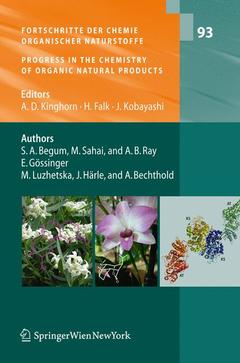Description
Fortschritte der Chemie organischer Naturstoffe / Progress in the Chemistry of Organic Natural Products, Vol. 93, 2010
Fortschritte der Chemie organischer Naturstoffe Progress in the Chemistry of Organic Natural Products Series, Vol. 93
Authors: Sahai Mahendra, Gössinger Edda, Luzhetska Marta, Härle Johannes, Begum Sajeli A., Ray Anil B.
Coordinators: Kinghorn A. Douglas, Falk Heinz, Kobayashi Junichi
Language: English
Subject for Fortschritte der Chemie organischer Naturstoffe /...:
Keywords
biochemistry; chemistry; natural product; polymer; synthesis
Approximative price 210.99 €
In Print (Delivery period: 15 days).
Add to cartPublication date: 09-2012
264 p. · 15.5x23.5 cm · Paperback
Approximative price 210.99 €
In Print (Delivery period: 15 days).
Add to cartPublication date: 06-2010
264 p. · 15.5x23.5 cm · Hardback
Description
/li>Contents
/li>Comment
/li>
List of Contributors
Nonconventional Lignans: Coumarinolignans, Flavonolignans, and Stilbenolignans
by Sajeli A. Begum, Mahendra Sahai, and Anil B. Ray
1. Introduction
2. Coumarinolignans
3. Flavonolignans
4. Stilbenolignans
References
Picrotoxanes
by Edda Gössinger
1. Introduction
2. Tabular Overview of the Picrotoxanes
3. Occurrence
4. Isolation of Picrotoxanes
5. Structure Determination of Picrotoxanes
6. Total Syntheses of Picrotoxanes
7. Biosynthesis of Picrotoxanes
8. Physiological Activity of Picrotoxanes
Abbreviations
References
Combinatorial and Synthetic Biosynthesis in Actinomycetes
by Marta Luzhetska, Johannes Härle, and Andreas Bechthold
1. Introduction
2. Combinatorial Biosynthesis and Synthetic Biosynthesis
References
Author Index
Subject Index
Written by recognized authorities in their fields
Providing a comprehensive and up-to-date review in topic
Includes supplementary material: sn.pub/extras




